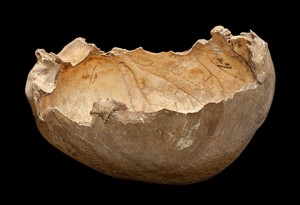Cave Bones Reveal More Proof of British Ice Age Cannibals

A human skull-cup uncovered in Gough’s Cave in Somerset, England. Photo via Natural History Museum.
Bones found inside Gough’s Cave in Somerset have revealed more evidence of cannibalistic behavior, including human tooth marks on many of the human bones.
A group of scientists from the Natural History Museum, University College London, and a number of Spanish universities have identified an advanced culture of butchering and carving of human remains.
This new research builds upon existing published studies into the newly dated 14,700 year old bones, including a 2011 paper in which Museum scientists revealed that the earliest known examples of human skull-cups were made in the UK.
We’ve identified a far greater degree of human modification than recorded in earlier research. We’ve found undoubting evidence for defleshing, disarticulation, human chewing, crushing of spongy bone, and the cracking of bones to extract marrow. Dr. Silvia Bello, Natural History Museum’s Department of Earth Sciences
Researchers believe the inhabitants of Gough’s cave were Magdalenians, a cultural group of hunter-gatherers who originated in southwest Europe. They are suspected to have entered Britain from Belgium and the Netherlands as the climate warmed up around 15,000 years ago after the last ice age.
While cannibal evidence has been found in other ancient sites in central and western Europe, this research suggests that cannibalism was part of a mortuary practice that combined intensive processing and consumption of the bodies with the ritual use of skull-cups.
Further analysis along the lines used to study Gough’s Cave will help to establish whether the type of ritualistic cannibalism practiced there is a regional (‘Creswellian’) phenomenon, or a more widespread practice found throughout the Magdalenian world. Simon Parfitt, University College London


Comments (1)
I wonder if the global magnetic reversal 0f 41,000 could have had much far wider consequences that what we believe.
There is the famous Red Lady of Paviland ( revealed a man) ceremoniously interred in a cave in England 33,000 y old . Combined with the effects of the Phlagaran volcanos at 40,000 y ago, what would have been the environment the survivors faced?
Comment